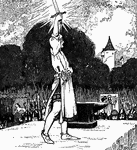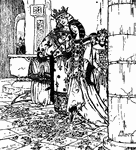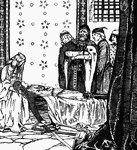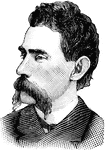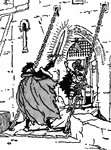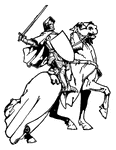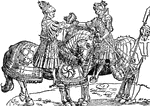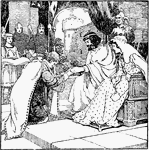Search for "knights"
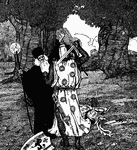
Merlin Saves Arthur
Arthur is about to be slain by the great Knight Pellinore but as he raises his sword against Arthur,…
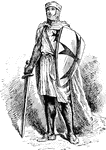
Knight Templar
"A Knight Templar. During the Crusades, there were military and religious orders. Between the first…

Tournament
"A tournament. The most famous amusement of the chivalrous age was the tournament, which took place…
Bedouin Lance Heads
"The Lance is a weapon consisting of a long shaft with a sharp point, much used, particularly before…
Bedouin Lance Heads
"The Lance is a weapon consisting of a long shaft with a sharp point, much used, particularly before…

Elizabeth Rodgers
Mrs. Rodgers was a delegate at the Knights of Labor convention at Richmond in 1887. She organized the…
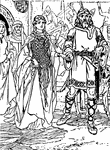
Tale of Ivanhoe
Scene from The Tale of Ivanhoe. "In the time of Richard I., the Saxons had not quite forgiven…
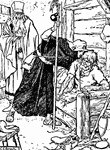
Tale of Ivanhoe
Scene from The Tale of Ivanhoe. "Cedric's son had been sent away because he had fallen in love…
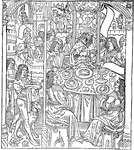
The King's Banquet
A print from the engraving, The King's Banquet from "Tristan" published by Antoine Verard.
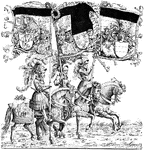
Horsemen, Three Abreast, with Banners
Horsemen, Three Abreast, with Banners, from the engraving 'The Triumphal Procession' by Hans Burgkmair.

Knights
A group of knights on a quest for King Arthur to find Mabon, the son of Modron, who was stolen from…

Sompting Church Tower
The church was originally built by the Saxons around 960, then was adapted by the Normans when William…

A Knight of St. John
It takes its origins from the Knights Hospitaller, an organization founded in Jerusalem in 1050 as an…
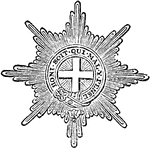
Order of the Garter Star
An illustration of the Order of the Garter Star. The Most Noble Order of the Garter is an order of chivalry,…
Order of the Garter's Garter
An illustration of the Order of the Garder's garter. The Garter is worn on ceremonial occasions around…
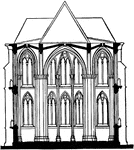
Section of Elisabeth Church, Marburg, Germany
The Elisabeth Church in Marburg was built by the Order of the Teutonic Knights in honor of Elisabeth…
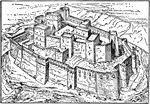
Krak des Chevaliers
Krak des Chevaliers was the headquarters of the Knights Hospitaller during the Crusades. It was expanded…
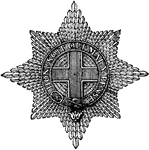
Order of the Garter Star
The star of the Order of the Garter. "Order of the Garter, the highest order of knighthood in Great…

Order of the Garter Collar
The collar of the Order of the Garter. "Order of the Garter, the highest order of knighthood in Great…
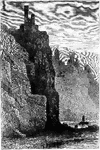
Castle of Neckarsteinach
One of four standing medieval castles in Neckarsteinach, also known as "Vier Burgeneck" because of its…
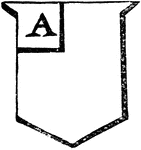
Canton Ordinary
"The canton is a square part of the escutcheon, usually occupying about one-eighth of the field; it…

Chaplet
"Argent, a chaplet proper. CHAPLET. An ancient ornament for the head, granted to gallant knights for…
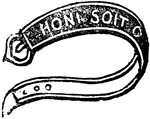
Garter
"GARTER. The insignia of the most noble order of the knights of the garter. It is formed of blue velvet…

Knights-Banneret
"KNIGHTS-BANNERET. This ancient and honourable order has become extinct. It obtained the title of banneret…
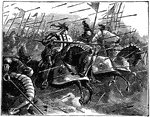
Knights Charging with Lances
An illustration of a group of knights charging on horseback with lances.

Two Knights Jousting with Lances
An illustration of two knights jousting with lances, shields, and armor.
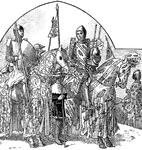
Knights and Noblemen on Horses Wearing Armor
The illustration shows two knights riding on horses. The knights and noblemen wore surcoats to hide…

Sirs John de Creke and John of Eltham Wearing Armor
Sirs John de Creke and John of Eltham wearing armor during the fourteenth century. The illustration…

Knight Tournament from Romance of King Meliadus
An illustration of fourteenth century tournament of knights wearing armor from Romance of King Maliadus…

Captain Cathcart
"Then came Lord Cathcart upon a powerful horse. He was chief of the knights. Two negro slaves wearing…

Helm of Baronet
"The Helm of Baronet and Knights is of steel, garnished with silver, and standing affronté; the…
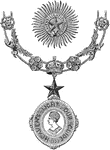
Insignia of the Order of the Star of India
"This Order was instituted by Her Majesty the Queen, in the year 1861, for bestowing honor upon the…
